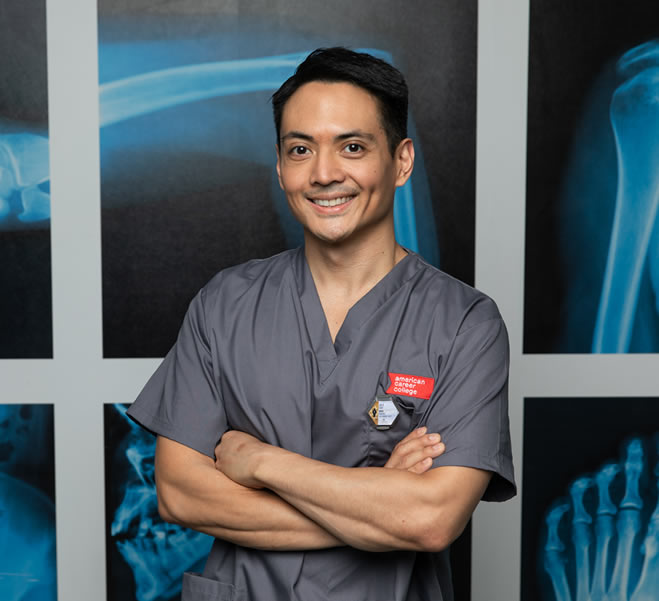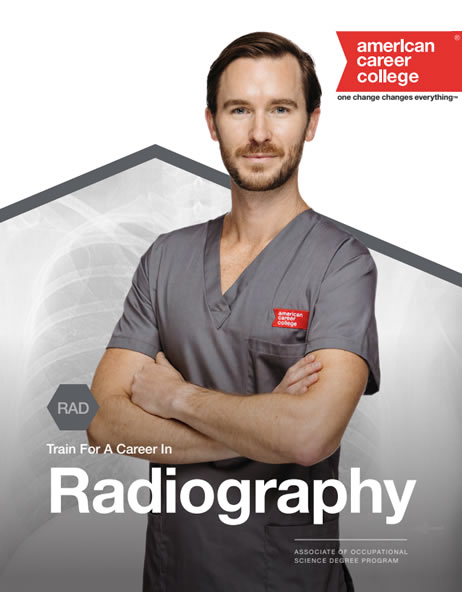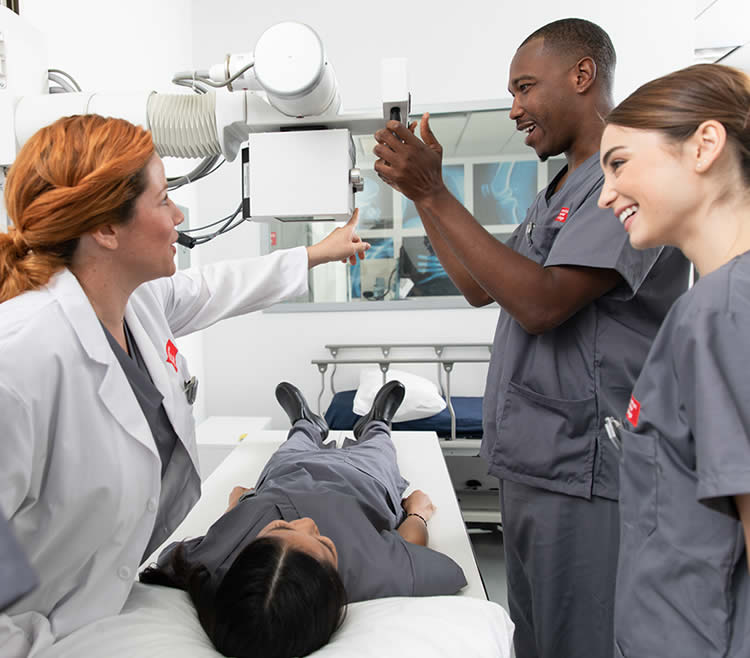| RAD120 |
Introduction to Radiologic Sciences |
10 | 0 | 1.0 |
This introductory course outlines the role of a radiologic technologist, the history of radiology, hospital and imaging department operations and exam reimbursement protocol. Students will be introduced to accreditation, certification, professional organizations, and the policies/regulations for the program. |
| CAREER200 |
Career Advantage † |
20 | 0 | 2.0 |
Career Advantage is a course designed to prepare students to develop career planning and job search skills. Thorough, relevant job search preparation is required to compete successfully for jobs in today's market. To prepare the student, the course will address six areas: resumes, job search process, networking techniques in a job search, interview planning and preparation, communication and workplace skills. |
| RAD150 |
Medical Terminology ‡ |
30 | 0 | 3.0 |
This course is an introduction to basic medical imaging terminology and prepares students for more advanced coursework in subsequent courses by providing an introduction to general medical imaging terminology. Students will study the roots, prefixes, suffixes, and abbreviations as well as general terms and their appropriate usage in medical imaging practice. |
| RAD220 |
Radiographic Physics |
30 | 0 | 3.0 |
This course provides the needed concepts of how a radiographic image is produced for diagnostic radiography, fluoroscopy, and mobile radiography. Atomic structure, magnetism, electricity and the circuitry of the x-ray unit are covered. |
| RAD250 |
Principles of Image Production |
70 | 0 | 6.0 |
This course will provide a knowledge base about the factors of x-ray image creation, which will include the equipment accessories and exposure factors that affect the quality of a radiograph. Students will participate in laboratory experiments to enhance the comprehension of image creation concepts. |
| RAD320 |
Radiographic Positioning I |
60 | 0 | 4.0 |
This course will provide the theory and laboratory practice for students to position patients for radiographic examinations of the respiratory system, abdomen, bony thorax, upper and lower extremities and related joints. Students will also be taught the use of proper radiation protection, and to analyze and critique the produced diagnostic images. |
| RAD350 |
Radiation Biology and Protection |
70 | 0 | 6.0 |
This course will provide the concepts of proper radiation protection protocols for the general public and imaging personnel. Regulatory agencies, dosage, shielding, and radiation protection principles for radiography, mobile radiography, and fluoroscopy will be explained. Students will perform laboratory experiments to enforce the concepts taught. |
| RAD370 |
Digital Imaging ‡ |
20 | 0 | 2.0 |
This course provides the base knowledge of computer/digital technology and the practical application of use within the radiologic field. |
| RAD420 |
Patient Care ‡ |
40 | 0 | 3.0 |
This course will provide the basic concepts and skills that are required for the appropriate standard of care for patients, which include communication, medical history documentation, and patient assistance. Students will demonstrate competence in taking vital signs and patient transfers. The importance of infection control and the technologists role in medical emergencies will be discussed. |
| RAD450 |
Radiographic Positioning II |
60 | 0 | 4.0 |
This course will provide the theory and laboratory practice for students to position patients for radiographic examinations of the vertebral column, cranium, facial bones, and sinuses. Students will also be taught the use of proper radiation protection, and to analyze and critique the produced diagnostic images. |
| RAD470 |
Law and Ethics in Imaging ‡ |
20 | 0 | 2.0 |
This course introduces the medico-legal and medical ethics principles of the healthcare profession specific to the imaging profession. |
| RAD500C |
Clinical Practicum I |
300 | 300 | 10.0 |
This course is a practical application of the concurrent theoretical learning. Competency based assignments in thorax, abdomen, extremities, vertebral column, cranium, facial bones, and sinuses to include mobile radiography will be introduced under the supervision of certified Radiologic Technologists. |
| RAD520 |
Radiographic Positioning III |
60 | 0 | 4.0 |
This course will provide the theory and laboratory practice for students to position patients for radiographic examinations of the gastrointestinal, genitourinary, and special procedures using contrast material. Students will also be taught the use of proper radiation protection, and to analyze and critique the produced diagnostic images. |
| RAD600C |
Clinical Practicum II |
300 | 300 | 10.0 |
This course is a practical application of the concurrent theoretical learning. Competency based assignments in thorax, abdomen, and extremities, vertebral column, cranium, facial bones, and sinuses will continue and competency based assignments for gastrointestinal, genitourinary and special procedures with contrast will be introduced under the supervision of certified Radiologic Technologists. |
| RAD620 |
Pharmacology/Venipuncture ‡ |
30 | 0 | 2.0 |
This course provides the basic methods for the administration of contrast material and the basic practices of venipuncture for the radiologic technologist. This course meets California Health and Safety Code, Section106985. |
| RAD700C |
Clinical Practicum III |
300 | 300 | 10.0 |
This course is a practical application of the concurrent theoretical learning. Competency based assignments in thorax, abdomen, extremities, vertebral column, cranium, facial bones, sinuses, gastrointestinal, genitourinary and special procedures with contrast will continue and competency based assignments for mobile radiography, surgical and interventional procedures done under the supervision of certified Radiologic Technologists. |
| RAD720 |
Introduction to Computed Tomography with Cross Sectional Anatomy ‡ |
40 | 0 | 4.0 |
This course provides the advanced student with an introduction to the principles and applications of computed tomography (CT) in the imaging department. |
| RAD800C |
Clinical Practicum IV |
300 | 300 | 10.0 |
This course is a practical application of all theoretical learning. Competency based assignments in thorax, abdomen, extremities, vertebral column, cranium, facial bones, sinuses, gastrointestinal, genitourinary and special procedures with contrast, mobile radiography, surgical and interventional procedures will continue under the supervision of certified Radiologic Technologists. |
| RAD900C |
Clinical Practicum V |
300 | 300 | 10.0 |
This course is a practical application of all theoretical learning. Competency based assignments in thorax, abdomen, extremities, vertebral column, cranium, facial bones, sinuses, gastrointestinal, genitourinary and special procedures with contrast, mobile radiography, surgical and interventional procedures will continue as well as clinical assignments for observing Computed Tomography (CT) under the supervision of certified Radiologic Technologists. |
| RADSEM1 |
Radiology Seminar I |
30 | 0 | 3.0 |
This course is a review of the content specifications that are critical for the American Registry of Radiologic Technologists (ARRT) certification examination. |
| RAD1000C |
Clinical Practicum VI |
360 | 360 | 12.0 |
This course is a practical application of all theoretical learning. Competency based assignments in thorax, abdomen, extremities, vertebral column, cranium, facial bones, sinuses, gastrointestinal, genitourinary and special procedures with contrast, mobile radiography, surgical and interventional procedures will continue as well as clinical assignments for observing Computed Tomography (CT), Magnetic Resonance Imaging (MRI), under the supervision of certified Radiologic Technologists. Clinical rotation for observing additional imaging modalities will be assigned. Additional imaging modalities will include ultrasound, mammography, radiation therapy, and nuclear medicine. |
| RADSEM2 |
Radiology Seminar II |
30 | 0 | 3.0 |
This course is a review of the content specifications that are critical for the American Registry of Radiologic Technologists (ARRT) certification examination. |









